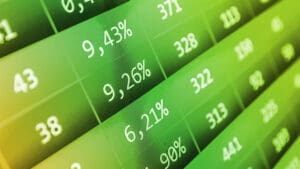As stock prices flirt with record highs, more investors are seeking shelter in gold, which is also at record highs. The interest reflects concerns about the state of economic affairs, such as governments debasing their currencies with more stimulus programs to offset the economic ravages of the coronavirus pandemic.
In many ways, though, the move to gold is curious. Easy-money policies are pushing investors far out on the proverbial risk curve, away from the safety of fixed income and toward the siren song of stocks. When interest rates are low, the cost of capital is inexpensive, and it pays to take risk—even if the central banks are creating massive government debt that may ultimately damage all of the wealth that’s created today.
Gold’s popularity is a testament to the apocalyptic visions of investors. They may or may not be wrong—but their timing seems suspect. In the absence of a sudden and sharp collapse of society, it seems hard to effectively position for currencies, or even modern civilization, to decay into a state in which gold is something more than an expensive security blanket for the rich.
“Gold bugs are the cicadas of the investment ecosystem,” says Steven Sosnick, Interactive Brokers’ chief strategist. “They hibernate for years and emerge in a frenzy in reaction to some fear that ultimately subsides, and then they go away until the next maelstrom sparks their re-emergence.”
Investors can trade the ebb and flow of gold enthusiasm by anticipating when gold bugs may emerge to drive gold prices to a new trading range and when they may exit. It’s a trade that is guided by watching the world sour and then turn sweeter, thanks to central banks, until more-upbeat macro events, or themes, overtake the old scary narrative.
We’ve traded this cycle many times in the past, and we prepare to do so again for the first time since an early June trade proved profitable. When the SPDR Gold Shares exchange-traded fund (ticker: GLD) was around $164, and associated options were trading briskly, we recommended that investors buy the September $165 call option for $6. The call is now worth about $21, representing a 250% return.
With the SPDR ETF around $191, investors can sell the November $190 put for $9 and buy the November $194 call for $8.90. The strikes were chosen to eliminate the cost of trading the ETF’s options. The so-called risk reversal—selling a put and buying a call with a higher strike price but a similar expiration—positions investors to buy the shares lower and to participate in rallies.
The trade is also appropriate for investors who want to own the SPDR Gold Shares as the price hovers around a record high. So far this year, the ETF is up 34%. It is up 37% over the past year. During the past 52 weeks, it has ranged from $136.12 to $193.13.
The strike-price selection expresses confidence that the ETF will move into a new, higher record trading range as fall approaches. The risk to the strategy is that it declines sharply, prompting investors to buy the shares at the put strike price or even at a sharply lower price. The U.S. dollar is another risk factor. The stronger the dollar, the weaker gold tends to become.
Yet the trade is primarily animated by the simple belief that the market mob will remain scared of their governments, Covid-19, and much else.
Moreover, one issue looms in the background that is not fully reflected in gold’s price: the U.S. presidential election.
If Donald Trump is re-elected, gold should benefit because his opponents will fear that he may take extraordinary actions in his second term. If Joe Biden wins, gold should advance because conservatives will fear that he will further debase the dollar with tax-and-spend policies.
Whatever the merits of those arguments, we do know is that gold is the feel-good asset in times of duress, and we are living in a bull market for anxiety.
—
Originally Posted on August 6, 2020 – The Rush Into Gold Isn’t Over Yet. How to Play It With Options.
Disclosure: Interactive Brokers Third Party
Information posted on IBKR Campus that is provided by third-parties does NOT constitute a recommendation that you should contract for the services of that third party. Third-party participants who contribute to IBKR Campus are independent of Interactive Brokers and Interactive Brokers does not make any representations or warranties concerning the services offered, their past or future performance, or the accuracy of the information provided by the third party. Past performance is no guarantee of future results.
This material is from Barron's and is being posted with its permission. The views expressed in this material are solely those of the author and/or Barron's and Interactive Brokers is not endorsing or recommending any investment or trading discussed in the material. This material is not and should not be construed as an offer to buy or sell any security. It should not be construed as research or investment advice or a recommendation to buy, sell or hold any security or commodity. This material does not and is not intended to take into account the particular financial conditions, investment objectives or requirements of individual customers. Before acting on this material, you should consider whether it is suitable for your particular circumstances and, as necessary, seek professional advice.
Disclosure: Options Trading
Options involve risk and are not suitable for all investors. For information on the uses and risks of options, you can obtain a copy of the Options Clearing Corporation risk disclosure document titled Characteristics and Risks of Standardized Options by going to the following link ibkr.com/occ. Multiple leg strategies, including spreads, will incur multiple transaction costs.
Disclosure: Futures Trading
Futures are not suitable for all investors. The amount you may lose may be greater than your initial investment. Before trading futures, please read the CFTC Risk Disclosure. A copy and additional information are available at ibkr.com.





















Join The Conversation
For specific platform feedback and suggestions, please submit it directly to our team using these instructions.
If you have an account-specific question or concern, please reach out to Client Services.
We encourage you to look through our FAQs before posting. Your question may already be covered!